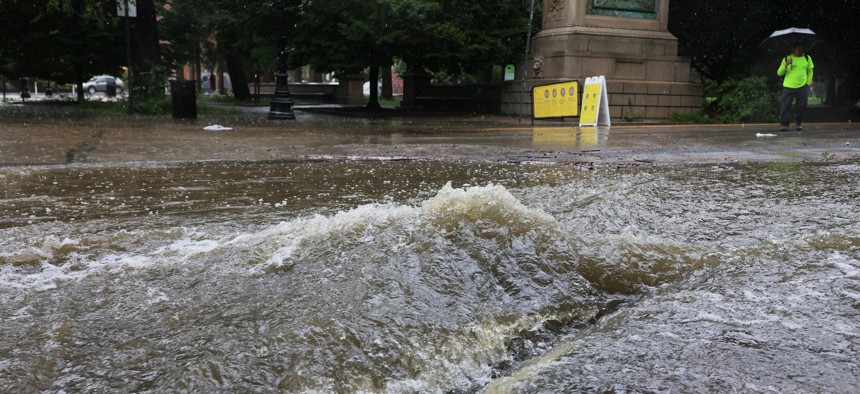Energy & Environment
NYC environment commish delivers sobering message to City Council on flooding
“We will need a much broader conversation about how much we are willing to pay, how much flooding we are willing to accept,” the city Environmental Protection Commissioner Rohit Aggarwala said.

Water gushes into a storm drain near Prospect Park as remnants of Tropical Storm Ophelia soak New York City in September 2023. Michael M. Santiago/Getty Images
Along with death and taxes, New Yorkers can be certain of flooding when it rains, said Department of Environmental Protection Commissioner Rohit “Rit” Aggarwala in sobering testimony before the City Council Friday morning. And that could lead to more death and taxes.
Despite $18 billion flowing into coastal resiliency projects over the 12 years since Superstorm Sandy bludgeoned New York City, the city’s spending on major sewer infrastructure has been insufficient, Aggarwala said. But that is exactly the kind of improvement the city needs now, as the frequency of flooding due to heavy rain – as opposed to coastal surges – has increased, including during Hurricane Ida in September 2021 and Tropical Storm Ophelia in September 2023. In both storms, over 8 inches of rain drenched the city, thousands of buildings were damaged and, in Ida’s case, 13 people drowned, many of whom were trapped in flooded basement apartments.
“There’s basically no scenario I can imagine in which we can tell every New Yorker, ‘we’re going to protect your home from all types of flooding.’ I just don’t think that’s a realistic future for us to aspire to,” Aggarwala told members of the Committee on Environmental Protection, Resiliency and Waterfronts at an oversight hearing on the city’s storm and groundwater infrastructure.
To upgrade the roughly 80 sewer sites identified by the DEP as flood risks, it would take a minimum of 30 years at the city’s current funding level of approximately $1 billion per year, according to the commissioner. “And this is just to achieve a basic level of resilience, not at all to protect every New Yorker against all storms,” Aggarwala said.
To protect against a storm like last September’s deluge, it could cost the city more than $250 billion, he said. Unlike the federal funding New York City saw in the aftermath of Sandy, those sewer upgrades would have to come out of city coffers and “may not even be physically possible in some areas given limited space for larger sewers beneath our streets,” Aggarwala told the Council.
The city has taken steps to reduce flooding from storms, including producing floodplain maps for building owners, clearing 692 miles of sewers, and requiring new large developments to install on-site stormwater management systems. But more is still needed, like greater state and federal aid, Aggarwala said. The city has also pushed state lawmakers to allow the Department of Design and Construction, which is responsible for managing capital construction projects, to function as a public authority, thereby streamlining the construction of stormwater management systems. So far, that lobbying has been unsuccessful.
Aggarwala also alluded to the underground residences that became deadly traps for so many people during the 2021 storm. “We’ve got to reckon with the fact that there are a lot of basements that really need to be used differently than they have been,” he said. In his written testimony, Aggarwala endorsed building code updates to further regulate basement apartments.
The hearing came on the heels of a report published Monday by New York City Comptroller Brad Lander, which claimed close to two-thirds of the city’s stormwater infrastructure projects are, on average, two years behind schedule, and two-thirds are over budget by a factor of three.
Asked about the budget overruns and delays, Aggarwala said he “strongly disagreed” with the comptroller’s characterization. “We are still working to figure out exactly what data was used,” he said. (Lander did not testify at the hearing because he was observing the Passover holiday, according to a spokesperson, though his office sent a copy of his report to the Council.) Aggarwala conceded that the department faced some overruns and delays due to increased construction costs across the board, disruptions during the pandemic, and a number of postponements within the city’s capital plan as a result of Mayor Eric Adams’ budget maneuvers.
According to the comptroller’s office, there are other DEP failures when it comes to storm preparedness. At the time Ophelia struck New York City in the fall, only 19 out of DEP’s 51 catch basin cleaning trucks were in service, the report stated, leaving more than half of the department’s 964 priority catch basins without inspection before the storm made landfall.
The catch basin trucks, a specialized vehicle with a hydraulic scoop designed for clearing out debris from underground sewer chambers, work year round to clear the city’s 150,000 catch basins, said DEP Deputy Commissioner Anastasios Georgelis. “Because we put them out all day long and they work constantly, they break down often.” In city budgets post-Ida, the Adams administration has allocated funding for “nine or 10” new trucks, which are still in the procurement process, according to Georgelis.
“Given the problem that we’re facing, that should be a priority to order a lot more than nine for the entire city of New York, right?” implored Council Member Robert Holden, who represents a flood-prone area of Queens.
In many ways, the heart of the issue is political not “technocratic,” Aggarwala argued.
“We will need a much broader conversation about how much we are willing to pay, how much flooding we are willing to accept, and what kinds of responsibilities we are willing to impose on homeowners,” he said. “DEP is the right agency to offer alternatives, but these are fundamentally political questions.”

